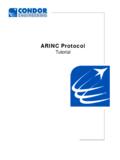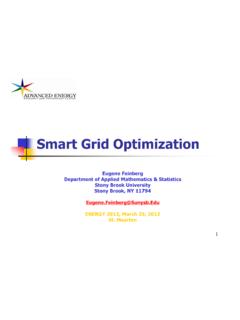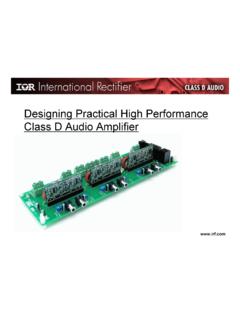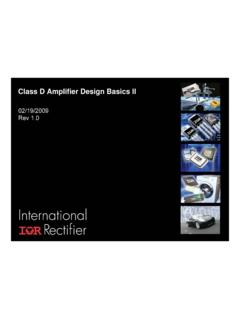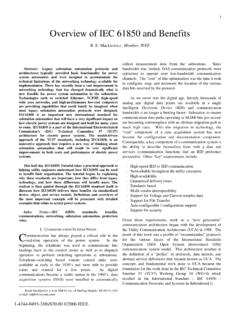Transcription of AN-A The Monolithic Operational Amplifier: A Tutorial Study
1 LM107,LM118. AN-A The Monolithic Operational amplifier : A Tutorial Study Literature Number: SNOA737. The Monolithic Operational amplifier : A Tutorial Study National Semiconductor The Monolithic Operational Appendix A A. amplifier : A Tutorial Study December 1974. Invited Paper It is the intent of this Study to develop an understanding for IEEE Journal of Solid-State Circuits, Vol. SC-9, No. 6 op amp behavior in as direct and intuitive a manner as pos- Abstract A Study is made of the integrated circuit opera- sible. This is done by using a variety of simplified circuit tional amplifier (IC op amp) to explain details of its behavior models which can be analyzed in some cases by inspection, in a simplified and understandable manner. Included are or in others by writing just a few equations. These simplified analyses of thermal feedback effects on gain, basic relation- models are generally developed from the single representa- ships for bandwidth and slew rate, and a discussion of pole- tive op amp configuration shown in Figures 1 and 2.
2 Splitting frequency compensation. Sources of second-order The rationale for starting with the particular circuit of Figure bandlimiting in the amplifier are also identified and some 1 is based on the following: this circuit contains, in simplified approaches to speed and bandwidth improvement are de- form, all of the important elements of the most commonly veloped. Brief sections are included on new JFET bipolar used integrated op amps. It consists essentially of two volt- circuitry and die area reduction techniques using transcon- age gain stages, an input differential amp and a common ductance reduction. emitter second stage, followed by a class-AB output emitter follower which provides low impedance drive to the load. INTRODUCTION. The two interstages are frequency compensated by a single The integrated circuit Operational amplifier (IC op amp) is small pole-splitting'' capacitor (see below) which is usually the most widely used of all linear circuits in production to- included on the op amp chip.
3 In most respects this circuit is day. Over one hundred million of the devices will be sold in directly equivalent to the general purpose LM101 [1], mA. 1974 alone, and production costs are falling low enough so 741 [2], and the newer dual and quad op amps [3], so the that op amps find applications in virtually every analog area. results of our Study relate directly to these devices. Even for Despite this wide usage, however, many of the basic per- formance characteristics of the op amp are poorly under- stood. TL/H/8745 1. FIGURE 1. Basic two-stage IC op amp used for Study . Minimal AN-A. modifications used in actual IC are shown in Figure 2. BI-FETTM is a trademark of National Semiconductor Corp. C1995 National Semiconductor Corporation TL/H/8745 RRD-B30M115/Printed in U. S. A. TL/H/8745 3. TL/H/8745 2. (b). (a). FIGURE 2. (a) Modified current mirror used to reduce dc offset caused by base currents in Q3 and Q4 in Figure 1.
4 (b) Darlington p-n-p output stage needed to minimize gain fall-off when sinking large output currents. This is needed to offset the rapid b drop which occurs in IC p-n-p's. more exotic designs, such as wide-band amps using feed- vout g b b b R. Av(0) e j m1 5 6 7 L (1). forward [4], [5], or the new FET input circuits [6], the basic vin 1 a ri2/r01 . analysis approaches still apply, and performance details where can be accurately predicted. It has also been found that a good understanding of the limitations of the circuit in Figure ri2 j b5(re5 a b6re6). 1 provides a reasonable starting point from which higher r01 j r04Ur02. performance amplifiers can be developed. It has been assumed that The Study begins in Section 2, with an analysis of dc and b7RL k r06Ur09, gm1 e gm2, b7 e b8. low frequency gain. It is shown that the gain is typically limit- The numerical subscripts relate parameters to transistor Q. ed by thermal feedback rather than electrical characteris- numbers ( , re5 is re of Q5, b6 is b0 pf Q6, etc.)
5 It has also tics. A highly simplified thermal analysis is made, resulting in been assumed that the current mirror transistors Q3 and Q4. a gain equation containing only the maximum output current have a's of unity, and the usually small loading of RB has of the op amp and a thermal feedback constant. been ignored. Despite the several assumptions made in ob- The next three sections apply first-order models to the cal- taining this simple form for (1), its accuracy is quite ade- culation of small-signal high frequency and large-signal quate for our needs. slewing characteristics. Results obtained include an accu- An examination of (1) confirms the way in which the amplifi- rate equation for gain-bandwidth product, a general expres- er operates: the input pair and current mirror convert the sion for slew rate, some important relationships between slew input voltage to a current gm1 Vin which drives the base of rate and bandwidth, and a solution for voltage follower be- the second stage.
6 Transistors Q5, Q6, and Q7 simply multi- havior in a slewing mode. Due to the simplicity of the results ply this current by b3 and supply it to the load RL. The finite in these sections, they are very useful to designers in the output resistance of the first stage causes some loss when development of new amplifier circuits. compared with second stage input resistance, as indicated Section 6 applies more accurate models to the calculation by the term 1/(1 a ri2/r01 ). A numerical example will help of important second-order effects. An effort is made in this our perspective: for the LM101A, I1 j 10 mA, I2 j 300 mA, section to isolate all of the major contributors to bandlimiting b5 e b6 j 150, and b7 j 50. From (1) and dc voltage in the modern amp. gain with RL e 2 kX is In the final section, some techniques for reduction of op Av(0) j 625,000 (2). amp die size are considered. Transconductance reduction The number predicted by (2) agrees well with that measured and layout techniques are discussed which lead to fabrica- on a discrete breadboard of the LM101A, but is much higher tion of an extremely compact op amp cell.
7 An example yield- than that observed on the integrated circuit. The reason for ing 8000 possible op amps per 3-in. wafer is given. this is explained in the next section. GAIN AT DC AND LOW FREQUENCIES B. Thermal Feedback Effects on Gain A. The Electronic Gain The typical IC op amp is capable of delivering powers of 50 . The electronic voltage gain will first be calculated at dc us- 100 mW to a load. In the process of delivering this power, ing the circuit of Figure 1 . This calculation becomes straight- the output stage of the amp internally dissipates similar forward if we employ the simplified transistor model shown power levels, which causes the temperature of the IC chip in Figure 3(a) . The resulting gain from Figure 3(b) is to rise in proportion to the output dissipated power. The silicon chip and the package to which it is bonded are good thermal conductors, so the whole chip tends to rise to the same temperature as the output stage.
8 Despite this, small 2. TL/H/8745 4. ro j 200/IC Monolithic NPN. ro j 80/IC Monolithic PNP. (a). TL/H/8745 5. (b). FIGURE 3. (a) Approximate q model for CE transistor at dc. Feedback element rm j b4ro is ignored since this greatly simplifies hand calculations. The error caused is usually less than 10 percent because b4, the intrinsic b under the emitter, is quite large. Base resistance rx is also ignored for simplicity. (b) Circuit illustrating calculation of electronic gain for op amp of Figure 1. Consideration is given only to the fully loaded condition (RL j 2 kX) where b7 is falling (to about 50) due to high current density. Under this condition, the output resistance of Q6 and Q9 are nondominant. temperature gradients from a few tenths to a few degrees Vint j g KTPd(2 c 10b3). centigrade develop across the chip with the output section j g cTPd (4). being hotter than the rest. As illustrated in Figure 4, these where cT e KT(2 c 10b3) V/W, since the transistor emit- temperature gradients appear across the input components ter-base drops change about b2 mV/ C.
9 Of the op amp and induce an input voltage which is propor- tional to the output dissipated power. For a thermally well designed IC op amp, in which the power output devices are made to approximate either a point or a To a first order, it can be assumed that the temperature line source and the input components are placed on the difference (T2 b T1) across a pair of matched and closely resulting isothermal lines (see below and Figure 8 ), typical spaced components is given simply by values measured for KT are (T2 b T1) j g KTPd C (3). KT & C/W (5). where in a TO-5 package. Pd power dissipated in the output circuit, The dissipated power in the class-AB output stage Pd is KT a constant with dimensions of C/W. written by inspection of Figure 4 : The plus/minus sign is needed because the direction of the V0Vs b V02. thermal gradient is unknown. In fact, the sign may reverse Pd e (6). RL. polarity during the output swing as the dominant source of heat shifts from one transistor to another.
10 If the dominant where input components consist of the differential transistor pair of Vs e a Vcc when V0 l 0. Figure 4, the thermally induced input voltage Vint can be Vs e bVee when V0 k 0. calculated as A plot of (6) is Figure 5 resembles the well-known class-AB. dissipation characteristics, with zero dissipation occurring 3. TL/H/8745 6. FIGURE 4. Simple model illustrating thermal feedback in an IC op amp having a single dominant source of self-heat, the output stage. The constant cT j mV/W and Pd is power dissipated in the output. For simplicity, we ignore input drift due to uniform heating of the package. This effect can be significant if the input stage drift is not low, see [7]. TL/H/8745 7. FIGURE 5. Simple class-B output stage and plot of power dissipated in the stage, Pd, assuming device can swing to the power supplies. Equation (6) gives an expression for the plot. for V0 e 0, a Vcc, bVee. Dissipation peaks occur for V0 e the amplifier and be sure it will not find an unstable operat- a Vcc/2 and b Vee/2.











